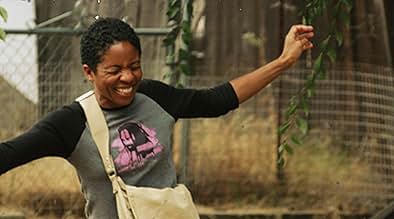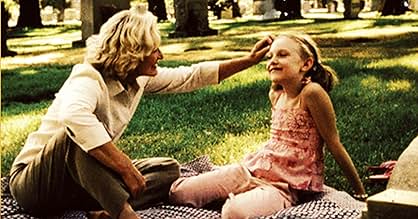Füge eine Handlung in deiner Sprache hinzuCaptives of the very relationships that define and sustain them, nine women resiliently meet the travails and disappointments of life.Captives of the very relationships that define and sustain them, nine women resiliently meet the travails and disappointments of life.Captives of the very relationships that define and sustain them, nine women resiliently meet the travails and disappointments of life.
- Auszeichnungen
- 9 Gewinne & 10 Nominierungen insgesamt
- Diana
- (as Robin Wright Penn)
Empfohlene Bewertungen
Ostensibly, the film is collection of 9 short stories or vignettes of 9 different women. In the first four, some characters appear in other episodes. The last five are connected by the word "connection". The last of the nine remains the most difficult and intriguing and an appropriate one to end the film.
The film captures each of the nine segments in a single shot without a cut. The film resembles various works of Robert Altman--even the long-shot of "The Player"--and the structure of "Magnolia" and "Crash." What "Nine Lives" has that the others do not is the Marquezian element of magical realism.
To explain this one has to begin at the final episode. "Nine lives" alludes to the cat. A cat is shown on a gravestone. A mother (old enough to be a grandmother) escorts a young girl (her daughter) to a grave and brings with her not flowers, but a bunch of grapes. She leaves the grapes behind on the grave. The final shot does not show the girl but the mother alone. Whose grave is it? Is the young girl real (or alive)? Did the mother bring grapes for a child who loved grapes, who is now merely a memory for an old woman? The stories are interconnected by relationships (mother-child) episode 1 and 9, parents and children (2 episodes of Holly and Samantha), husband and wife (Camille) and the trio of husband, wife and lover (Diana, Lorna and Ruth).
To savor the richness of the film, one has to go beyond each segment and look at the links the director provides to see the breaks in relationships and the ultimate reconciliation the full film provides. In the first episode, the viewer sees a break in the relationships. In the finale there is reconciliation even in death. In between, divorced couples consent to sex, a young teenager appears to be more sensible than her quarreling parents by giving up a chance for better education to keep the fragile family together, and another fighting couple remind you of Albee's George and Martha in "Who's Afraid of Virginia Woolf?" An abused daughter realizes she cannot kill her father. A faithful husband helps his wife get emotionally ready for a mastectomy.
If there is a flaw, you can point out that it looks at nine women rather than nine men. But then in literature, cats are associated with females rather than men, and the director was born to a family who appreciated literature.
There is little that is spoken in this film. But each word is important to understand and enjoy the film. It is a film that deserved the Locarno Film festival honors. Personally, I loved the performances of Glen Close, Robin Wright Penn, the lovely Amanda Seyfried, Elpida Carillo and Ian McShane. But the entire cast was great--like any Altman film. Garcia, unlike Altman, stresses on the spoken word, not merely the images and music.
I saw the film at the recently concluded Dubai Film Festival. Was it a coincidence that Marquez's friend and Chilean filmmaker of repute--Miguel Littin--was outside the cinema hall trying to get a feel of the reaction of the audience to film made by his friend's son without being noticed?
NINE LIVES is simply the reporting of nine women and their surrounding characters who are coping with an emotional crisis involving relationships with a parent, child, lover, husband, or sister and the manner in which each woman deals with keeping her life intact despite the trials of everyday living. Imagine walking down a street, as a flaneur, observing glimpses of a person and conversation that lasts only as long as the time you approach, pause and pass on by and you have an idea of the technique García uses. These little short stories are the stuff of life we all encounter: García pauses long enough to let them make an impact.
Part of the beauty of this film is the sterling cast which includes some of our finest actors - Kathy Baker, Amy Brenneman, K Callan, Glenn Close, Stephen Dillane, Dakota Fanning, Holly Hunter, Jason Isaacs, Joe Mantegna, Ian McShane, Mary Kay Place, Aidan Quinn, Sissy Spacek, Robin Wright Penn - the list goes on. There is a sense of ensemble commitment to this film despite that only occasionally do the characters overlap. The writing is terse, understated, always saying just enough to arrest our attention before moving on, much the way life keeps passing. A very fine work, and one that reminds us that great movies from quiet stories come. Grady Harp
As a viewer, you have to live with lots of unresolved issues since +- 15 minutes provides only a snapshot of these women's lives. But Garcia rewards the thoughtful viewer as themes emerge from the collection of sketches.
Like in "Things You Can Tell..." the acting if first-class and scenarios authentic.
The cast alone makes this movie worthwhile. How does Garcia get such terrific talent? I suspect that his short story format allows actresses/ors to fit in a quick Garcia movie between their big paycheck films, allowing them to up their credibility with an art-house flick. But these aren't throw-away roles... they really give it their best! Of course, you're going to like some segments better than others. I found it odd that Garcia LED with what I felt was one of the weaker segments (The LA Jail). He ends with one of the best (Dakota Flanning and Glenn Close). My favorite was Robin Wright Penn and Jason Isaacs in the grocery store. It touched me very deeply.
The final story (Flanning and Close) is one of the sweetest and lightest which bring up my biggest criticism of the film... Garcia could lighten up a little. A little more humor and a little more playfulness could really help his next film... and I hope he does make another in this same style.
My other criticism is of the cinematography which I don't find appealing... it tends to be overexposed and needlessly bleak at times. Admittedly, it does accurately convey both the emotions of the women and the feel of Southern California but I think it is overused. (Possibly he is trying to make the best of low budgets.) In summary.. this film is DEFINITELY worth watching as long as you are willing to accept it for what it is... a collection of snapshots rather than the more developed characters and story that traditional movies provide. If you are renting, I suggest that you also pick up a copy of "Things you can tell..." and have a mini Garcia film festival.
WUSSTEST DU SCHON:
- WissenswertesWhile the film was largely overlooked by moviegoers, critical reaction was generally favorable and both Roger Ebert and Richard Roeper included it on the year end top 10 lists.
- PatzerIn the "Sonia" chapter a camera mans arm is visible in the mirror on the floor in the living room.
- Zitate
Lorna: What? I don't want to be here with you.
Andrew: I can't stop thinking of you.
Lorna: Andrew.
Andrew: I can't.
Lorna: Andrew, your wife's funeral's in here.
Andrew: She's not my wife. You're my wife. I married her because you left.
Lorna: I have an idea. Why don't you and I make out in front of her dead body? It would excite you, huh?
Andrew: This has nothing to do with her.
Lorna: You don't think so? You don't think this is her day?
Andrew: She's dead now! She doesn't have to worry now!
Lorna: You shit, you've gone crazy.
Andrew: No I haven't.
[tries to touch her]
Andrew: I masturbate thinking about you.
[Lorna turns and walks in the room]
Andrew: That time in the car - in Santa Cruz... You drove me crazy. Nobody can make me come like that. Only you can do that.
[approaching her]
Andrew: Do you think about me? Tell me! Tell me if you think about me sometimes!
[looks her in this eyes, closely]
Andrew: If you don't, I'll get out of here right now.
Lorna: Did she know about this?
[Andrew kisses Lorna]
- VerbindungenFeatured in Siskel & Ebert & the Movies: The Best Films of 2005 (2005)
- SoundtracksMemories
Written by Francois Paterson, Dominic Paterson and Christelle Pechin
Performed by Soma Sonic
Courtesy of Subsonic Recordings
Top-Auswahl
- How long is Nine Lives?Powered by Alexa
Details
- Erscheinungsdatum
- Herkunftsländer
- Offizielle Standorte
- Sprachen
- Auch bekannt als
- Дев'ять життів
- Drehorte
- Produktionsfirmen
- Weitere beteiligte Unternehmen bei IMDbPro anzeigen
Box Office
- Budget
- 500.000 $ (geschätzt)
- Bruttoertrag in den USA und Kanada
- 478.830 $
- Eröffnungswochenende in den USA und in Kanada
- 28.387 $
- 16. Okt. 2005
- Weltweiter Bruttoertrag
- 1.591.523 $
- Laufzeit1 Stunde 55 Minuten
- Farbe
- Sound-Mix
- Seitenverhältnis
- 1.85 : 1
Zu dieser Seite beitragen










































